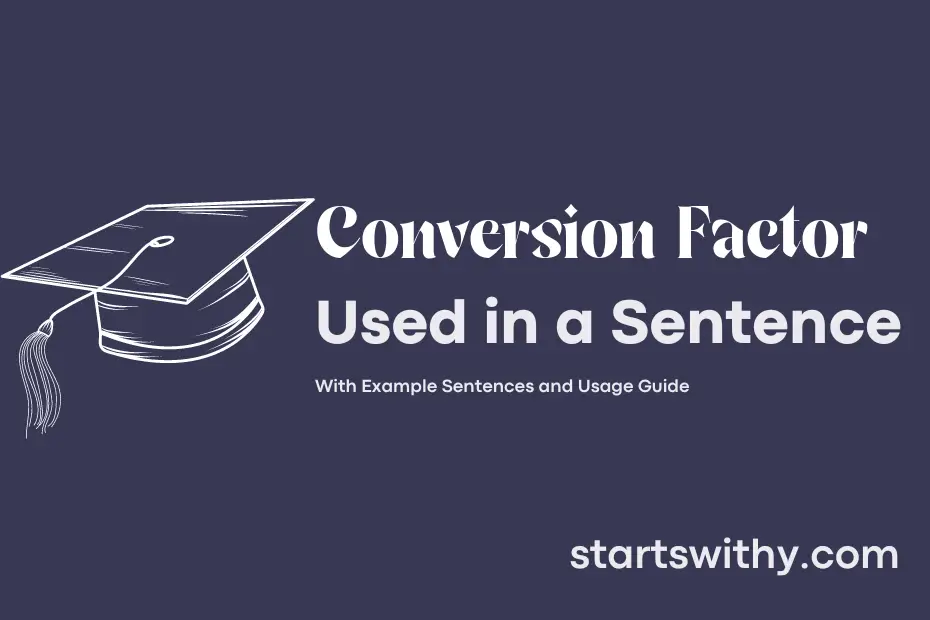Are you familiar with the term “conversion factor”? A conversion factor is a number used to convert one unit of measurement to another, making it a crucial tool in various fields from math and physics to everyday tasks like cooking and shopping.
Understanding conversion factors can simplify complex calculations and help ensure accuracy when converting values from one system to another. By knowing how to properly apply conversion factors, you can effortlessly switch between units such as length, weight, volume, and more, making your tasks more efficient and precise.
7 Examples Of Conversion Factor Used In a Sentence For Kids
- Conversion factor helps us change from one unit to another easily.
- The conversion factor for meters to centimeters is 100.
- We can use a conversion factor to change hours to minutes.
- Remember to multiply by the correct conversion factor.
- The conversion factor for liters to milliliters is 1000.
- Using a conversion factor can make math problems simpler.
- Practice using conversion factors to get better at changing units.
14 Sentences with Conversion Factor Examples
- Conversion factor can be handy when converting between different units of measurement, such as kilograms to pounds.
- As a college student studying physics, you will often need to use conversion factors when working with different units like meters and centimeters.
- When doing experiments in chemistry lab, it’s important to be familiar with various conversion factors to accurately convert between different units like moles and grams.
- Engineering students frequently use conversion factors when solving numerical problems involving units like meters and inches.
- Conversion factor is essential in fields like economics, where you may need to convert between currencies using an exchange rate.
- In mathematics, understanding conversion factors is crucial when dealing with unit conversions in topics like geometry and trigonometry.
- When studying abroad, you may need to use conversion factors to convert temperature measurements from Celsius to Fahrenheit or vice versa.
- Accounting students must be proficient in using conversion factors to convert financial figures between different currencies for international transactions.
- Being aware of conversion factors is beneficial for students pursuing a career in healthcare, especially when converting between units like milligrams and grams for medication dosages.
- Students in environmental science courses often utilize conversion factors to convert energy units when analyzing renewable energy sources.
- Conversion factor helps biology students convert between different units when studying topics like cell size or organism growth rates.
- As a computer science student, you may need to use conversion factors when converting between different data storage units like bits and bytes.
- When studying history, it’s helpful to know conversion factors for different historical calendars, such as converting dates between the Gregorian and Julian calendars.
- Art students may use conversion factors to translate measurements between different sizing systems for materials like canvas or paper.
How To Use Conversion Factor in Sentences?
To use Conversion Factor in a sentence, you need to understand what it means first. A Conversion Factor is a ratio or factor that allows you to convert between different units of measurement.
Here’s a simple guide on how to use Conversion Factor in a sentence:
-
Identify the Conversion Factor needed: Determine the relationship between the two units you are converting between. For example, if you are converting inches to centimeters, the Conversion Factor is 2.54 cm per 1 inch.
-
Set up your sentence: Start by writing the quantity you want to convert, followed by the unit you are converting from.
-
Multiply by the Conversion Factor: Multiply your starting quantity by the Conversion Factor. Make sure to place the Conversion Factor in such a way that the units cancel out correctly, leaving you with the desired unit.
-
Write the final sentence: Finish your sentence by writing the new quantity along with the unit you are converting to.
For example, if you want to convert 12 inches to centimeters, you would write: “12 inches * 2.54 cm/1 inch = 30.48 cm.” Therefore, 12 inches is equal to 30.48 centimeters.
By following these steps, you can effectively use Conversion Factor in a sentence to convert between different units of measurement.
Conclusion
In summary, sentences with conversion factors are commonly used to change units of measurement from one scale to another, making it easier to compare or quantify various quantities. These sentences typically involve multiplying or dividing by a specific conversion factor to achieve the desired unit conversion. For instance, “To convert 5 miles to kilometers, multiply by the conversion factor 1.60934 kilometers per mile.” This allows for a straightforward and accurate transformation between different units, enhancing communication and understanding in fields such as math, science, and engineering.
It is essential to understand the concept of conversion factors and how to use them effectively to ensure accurate and precise conversions. By mastering the art of formulating sentences with conversion factors, individuals can seamlessly navigate between different systems of measurement and facilitate clear communication when discussing quantities in diverse contexts.



